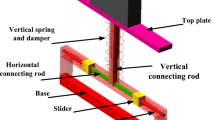Abstract
High-static–low-dynamic-stiffness (HSLDS) vibration isolators seek to widen the frequency range of isolation by decreasing the dynamic stiffness so as to reduce the natural frequency, while maintaining the same static displacement as equivalent linear isolators. However, in many cases especially under light damping or large excitations, the peak transmissibility is very large and the hardening nonlinearity causes the transmissibility curve to bend to the right seriously or in other words causes the jump phenomenon, resulting in a greatly reduced isolation region. In this paper, an auxiliary system is added to the HSLDS isolator to overcome these disadvantages, with the static displacement of the isolation object remaining unchanged. Coefficient-varying harmonic balance method is proposed in this paper to find the dynamic response and most importantly analyze the stability of the steady-state response. The isolation performance of the HSLDS-AS isolator, which is evaluated by displacement transmissibility, is compared with that of the equivalent HSLDS isolator. The effects of system parameters on the isolation performance are investigated. It is shown that the auxiliary system can lower the peak transmissibility and eliminate the jump phenomenon, resulting in a wide isolation region, and the HSLDS-AS isolator has strong designability with many parameters tunable.


















Similar content being viewed by others
References
Carrella, A.: Passive vibration isolators with high-static–low-dynamic stiffness. Ph.D. Thesis, ISVR, University of Southampton, United Kingdom (2008)
Ibrahim, R.A.: Recent advances in nonlinear passive vibration isolators. J. Sound Vib. 314, 371–452 (2008)
Ahn, H.J.: Performance limit of a passive vertical isolator using a negative stiffness mechanism. J. Mech. Sci. Technol. 22, 2357–2364 (2008)
Kim, K.R., You, Y.H., Ahn, H.J.: Optimal design of a QZS isolator using flexures for a wide range of payload. Int. J. Precis. Eng. Manuf. 14, 911–917 (2013)
Carrella, A., Brennan, M.J., Waters, T.P.: Static analysis of a passive vibration isolator with quasi-zero-stiffness characteristic. J. Sound Vib. 301, 678–689 (2007)
Carrella, A., Brennan, M.J., Kovacic, I., Waters, T.P.: On the force transmissibility of a vibration isolator with quasi-zero-stiffness. J. Sound Vib. 322, 707–717 (2009)
Carrella, A., Brennan, M.J., Waters, T.P., Lopes Jr., V.: Force and displacement transmissibility of a nonlinear isolator with high-static-low-dynamic-stiffness. Int. J. Mech. Sci. 55, 22–29 (2012)
Carrella, A., Friswell, M.I., Zotov, A., Ewins, D.J., Tichonov, A.: Using nonlinear springs to reduce the whirling of a rotating shaft. Mech. Syst. Signal Process. 23, 2228–2235 (2009)
Kovacic, I., Brennan, M.J., Waters, T.P.: A study of a nonlinear vibration isolator with a quasi-zero stiffness characteristic. J. Sound Vib. 315, 700–711 (2008)
Lan, C.C., Yang, S.A., Wu, Y.S.: Design and experiment of a compact quasi-zero-stiffness isolator capable of a wide range of loads. J. Sound Vib. 333, 4843–4858 (2014)
Shaw, A.D., Neild, S.A., Wagg, D.J., Weaver, P.M., Carrella, A.: A nonlinear spring mechanism incorporating a bistable composite plate for vibration isolation. J. Sound Vib. 332, 6265–6275 (2013)
Huang, X.C., Liu, X.T., Hua, H.X.: On the characteristics of an ultra-low frequency nonlinear isolator using sliding beam as negative stiffness. J. Mech. Sci. Technol. 28, 813–822 (2014)
Huang, X.C., Liu, X.T., Sun, J.Y., Zhang, Z.Y., Hua, H.X.: Effect of the system imperfections on the dynamic response of a high-static-low-dynamic stiffness vibration isolator. Nonlinear Dyn. 76, 1157–1167 (2014)
Peng, C., Gong, X.L., Zong, L.H., Guo, C.Y., Yan, Q.F., Zhou, H.: Design and tests for a new type nonlinear low-frequency passive vibration isolation system. J. Vib. Shock 32, 6–11 (2013). (in Chinese)
Wu, Z.J., Jing, X.J., Bian, J., Li, F.M., Allen, R.: Vibration isolation by exploring bio-inspired structural nonlinearity. Bioinspir. Biomin. 10, 1748–3190 (2015)
Wu, Z.J., Jing, X.J., Sun, B., Li, F.M.: A 6DOF passive vibration isolator using X-shape supporting structures. J. Sound Vib. 380, 90–111 (2016)
Sun, X.T., Jing, X.J.: A nonlinear vibration isolator achieving high-static-low-dynamic stiffness and tunable anti-resonance frequency band. Mech. Syst. Signal. Process. 80, 166–188 (2016)
Robertson, W.S., Kidner, M.R.F., Cazzolato, B.S., Zander, A.C.: Theoretical design parameters for a quasi-zero stiffness magnetic spring for vibration isolation. J. Sound Vib. 326, 88–103 (2009)
Xu, D.L., Yu, Q.P., Zhou, J.X., Bishop, S.R.: Theoretical and experimental analyses of a nonlinear magnetic vibration isolator with quasi-zero-stiffness characteristic. J. Sound Vib. 332, 3377–3389 (2013)
Wu, W.J., Chen, X.D., Shan, Y.H.: Analysis and experiment of a vibration isolator using a novel magnetic spring with negative stiffness. J. Sound Vib. 333, 2958–2970 (2014)
Li, Q., Zhu, Y., Xu, D.F., Hu, J.C., Min, W., Pang, L.C.: A negative stiffness vibration isolator using magnetic spring combined with rubber membrane. J. Mech. Sci. Technol. 27, 813–824 (2013)
Shin, K.H.: On the performance of a single degree-of-freedom high-static-low-dynamic stiffness magnetic vibration isolator. Int. J. Precis. Eng. Manuf. 15, 439–445 (2014)
Dong, G.X., Zhang, X.N., Xie, S.L., Yan, B., Luo, Y.J.: Simulated and experimental studies on a high-static-low-dynamic stiffness isolator using magnetic negative stiffness spring. Mech. Syst. Signal. Process. 86, 188–203 (2017)
Lu, Z.Q., Brennan, M.J., Yang, T.J., Li, X.H., Liu, Z.G.: An investigation of a two-stage nonlinear vibration isolation system. J. Sound Vib. 332, 1456–1464 (2013)
Wang, X.L., Zhou, J.X., Xu, D.L., Ouyang, H.J., Duan, Y.: Force transmissibility of a two-stage vibration isolation system with quasi-zero stiffness. Nonlinear Dyn. 87, 633–646 (2017)
Acknowledgements
The authors would like to thank Prof. Zhao for the helpful suggestions on the results presented in this paper.
Author information
Authors and Affiliations
Corresponding author
Ethics declarations
Conflict of interest
The authors declare that there is no conflict of interest regarding the publication of the paper.
Rights and permissions
About this article
Cite this article
Liu, C., Yu, K. A high-static–low-dynamic-stiffness vibration isolator with the auxiliary system. Nonlinear Dyn 94, 1549–1567 (2018). https://doi.org/10.1007/s11071-018-4441-5
Received:
Accepted:
Published:
Issue Date:
DOI: https://doi.org/10.1007/s11071-018-4441-5




